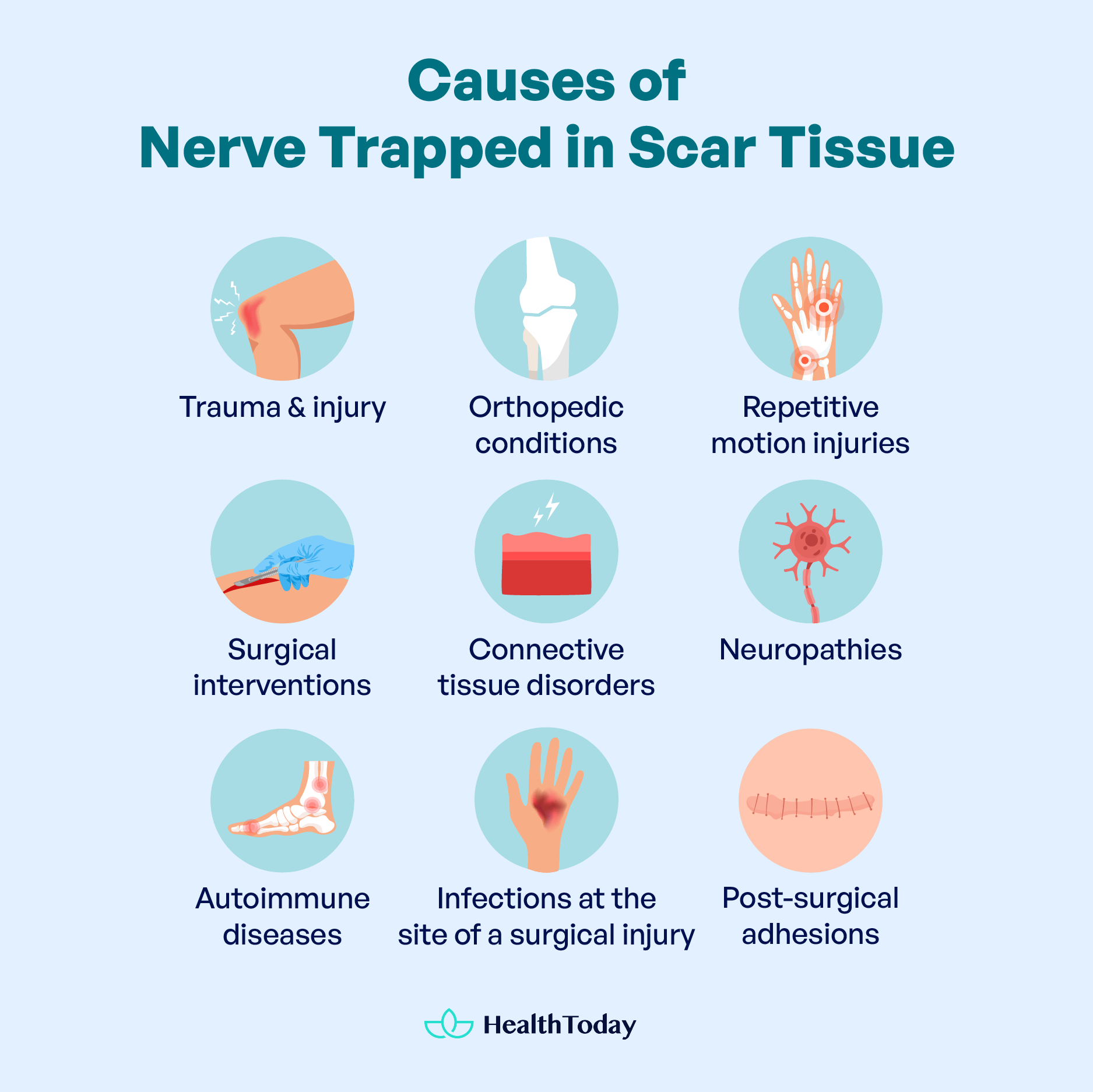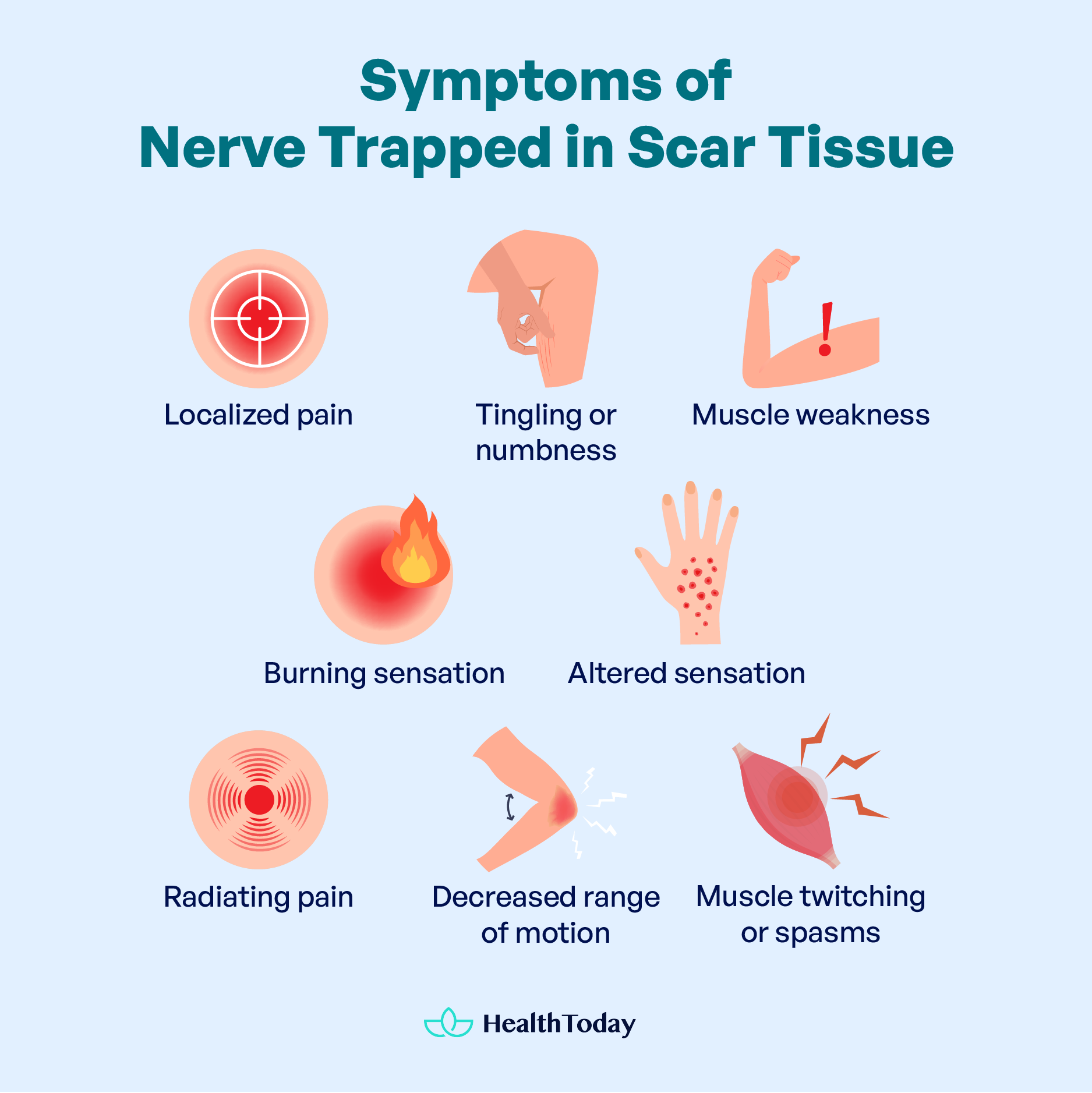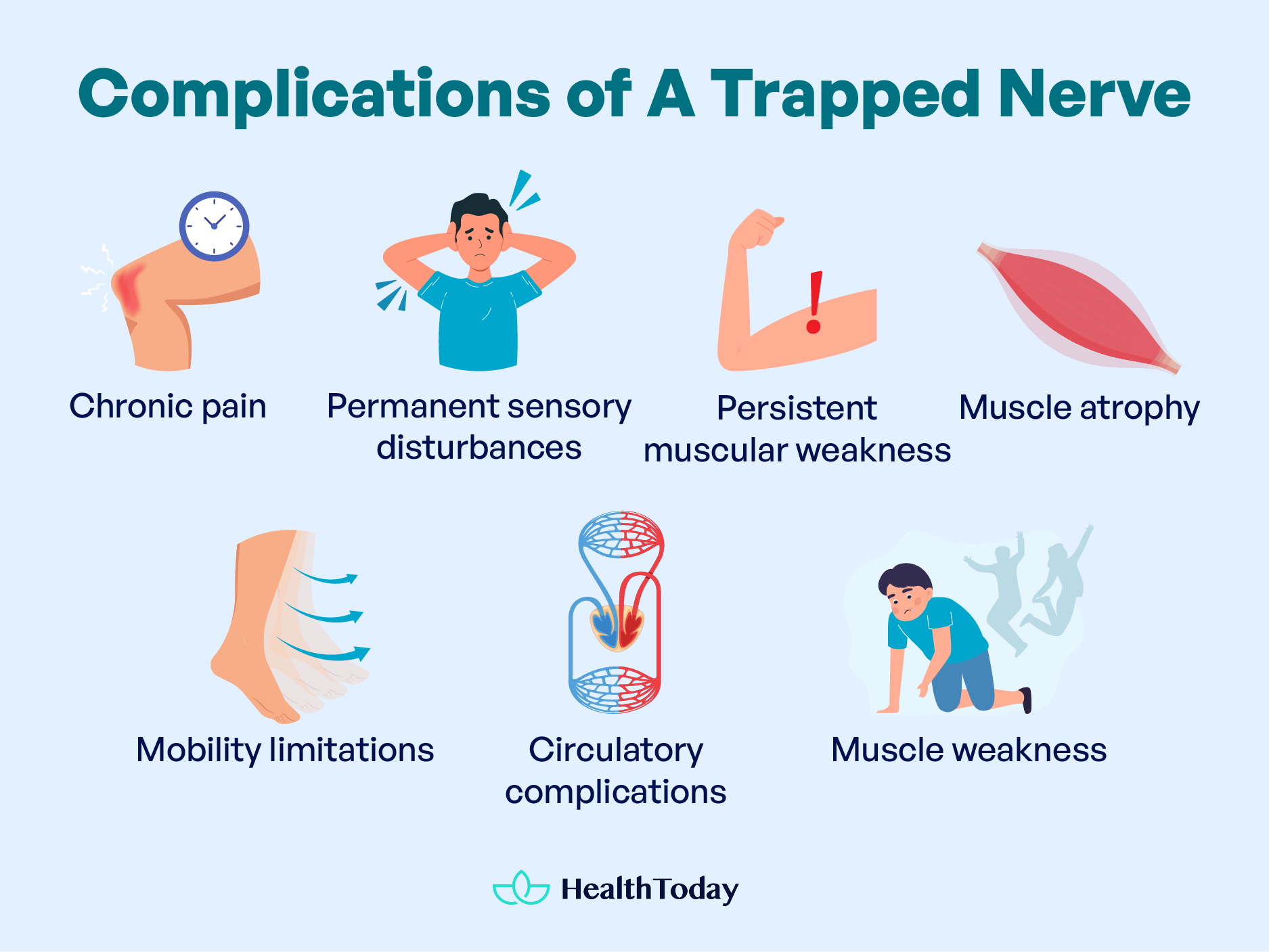Table of Contents
Painful scarring due to nerve entrapment is common but often underdiagnosed because it is so difficult to associate. Nerve entrapment in scar tissue is a complex medical condition when nerves become trapped or compressed in fibrous tissue during the healing process. This process can occur weeks or months after surgery or trauma. Generally, when it occurs, it generates neuropathic pain characterized by burning, tingling, sensation of needles and pins, hyperalgesia, and electric shocks, among others.
In this article, we will address the most important aspects of nerve entrapment, exploring the mechanisms, symptoms, risks, causes, and different treatments.
What is a nerve trapped in scar tissue?
When tissue is damaged, either due to trauma or surgical interventions, a process of tissue repair, called scarring, is initiated. This represents a crucial component of the biological response to injuries and medical procedures. The resulting scar tissue, composed mainly of collagen fibers, is deposited to restore and protect the damaged structures, playing a fundamental role in restoring tissue integrity.
From a physiological perspective, healing has four stages (1):
- Hemostasis: It is the immediate response of the body to an injury, where clot formation occurs to stop bleeding.
- Inflammation: It begins within minutes of hemostasis and can last several days. Its function is to attract immune system cells to the injured site to eliminate pathogens and damaged tissues. Inflammation, in this context, prepares the ground for repair.
- Proliferation: At this stage, the cells responsible for producing collagen move to the injured site and begin to synthesize the extracellular matrix. New blood vessels are also formed to provide nutrients to the affected area.
- Maturation: This stage can extend for months or even years after the initial injury. Here, the existing collagen is organized so the damaged tissue regains its previous strength.
In some instances, fibrous tissue formed during the healing process may result in entrapment of nearby nerves. This complication arises due to excessive deposition of collagen and other components of the extracellular matrix.
Nerve entrapment can manifest in response to surgical trauma, repetitive injury, or chronic inflammation, with postsurgical adhesions being abnormal connections between tissues that may further contribute to this condition. Understanding this complex process provides a deeper insight into how the body heals and how, in certain circumstances, this healing can have additional complications.
Causes

Scar tissue nerve entrapment may be associated with various conditions, injuries, or surgical interventions. Certain medical conditions or circumstances may increase the risk of developing scar tissue nerve entrapment. Some conditions include (1, 2, 3, 4, 5, 6):
- Trauma and injury: Injuries, such as deep cuts, deep full-thickness burns, or trauma, can lead to scar tissue formation. If scar tissue compresses nearby nerves, nerve entrapment can occur.
- Orthopedic conditions: Certain orthopedic conditions, such as fractures or dislocations, may require surgical procedures for stabilization. Surgical healing and the healing process may contribute to nerve entrapment. The most common orthopedic causes are carpal tunnel and median nerve entrapment.
- Repetitive motion injuries: Conditions involving repetitive motion or overuse of particular body parts, such as carpal tunnel syndrome, can lead to scar tissue formation and subsequent nerve entrapment.
- Surgical interventions: Nerve entrapment is a rare complication of some upper limb surgical interventions. Tissue manipulation during surgery, postoperative scarring, and scar formation may contribute to nerve entrapment.
- Connective tissue disorders: These are less common causes. Disorders affecting connective tissues, such as Ehlers-Danlos syndrome or systemic lupus erythematosus, can predispose people to abnormal scar formation and nerve entrapment.
- Neuropathies: Certain neuropathic conditions, such as diabetic neuropathy, can involve nerve injury and altered healing responses, increasing the risk of nerve entrapment within scar tissue.
- Autoimmune diseases: Autoimmune disorders, including rheumatoid arthritis, can cause chronic inflammation and abnormal healing responses, contributing to scar tissue formation around nerves.
- Infections at the site of a surgical injury: Infections at the site of a surgical injury or incision can lead to increased inflammation and tissue damage, resulting in abnormal scar tissue and nerve entrapment.
- Post-surgical adhesions: Adhesions are abnormal connections between tissues that can develop after surgery, contributing to nerve entrapment.
It is critical to keep in mind that the risk of nerve entrapment in scar tissue depends on several factors and that not everyone with a surgical scar or injury will suffer from this complication. However, appropriate treatment, such as physical therapy and scar tissue decompression techniques, can help prevent or alleviate the symptoms of nerve entrapment.
What are the symptoms?

Symptoms of nerve entrapment in scar tissue are due to compromised function of the affected nerve. When the pain is caused by nerve involvement, it is called neuropathic pain. These could include (7, 8, 9):
- Localized pain: One of the main symptoms is pain at the site of nerve entrapment. The pain may be sharp, stabbing, or constant and often intensifies with movement or pressure over the affected area.
- Tingling or numbness: People suffering from nerve entrapment may also have a tingling or numb sensation. This sensation may radiate along the path of the affected nerve and may be accompanied by a “pins and needles” sensation.
- Muscle weakness: Weakness of the muscles controlled by the trapped nerve is a common symptom. This weakness can affect functional abilities and cause coordination difficulties.
- Burning sensation: Some people may describe a burning sensation in the area where the nerve is trapped. This may contribute to the general discomfort associated with the pain.
- Altered sensation: Changes in sensation, such as hypersensitivity or loss of sensation, may occur. Patients may notice that the affected area responds differently to touch or temperature.
- Radiating pain: Nerve entrapment may cause pain to radiate along the nerve pathway.
- Decreased range of motion: Nerve entrapment can cause stiffness and decreased range of motion in the affected area. This limitation may be particularly noticeable during movement.
- Muscle twitching or spasms: In some cases, nerve entrapment may trigger involuntary muscle movements, such as twitching or spasms, due to the temporary interruption of nerve signals.
However, symptoms may vary depending on the affected nerve and the cause of the nerve entrapment. In addition, individual responses may differ, so it is important to see a physician for an appropriate diagnosis and treatment. If you suspect nerve entrapment in scar tissue, consult your primary care physician to discuss what should be done.
What are the complications that a trapped nerve can cause?

Nerve entrapment, if not detected and correctly treated, can have long-term complications. These complications depend on the location of the lesion and the time of evolution. Some associated risks include (10, 11, 12):
- Chronic pain: A nerve entrapment not properly treated can generate chronic pain in the affected area. This pain can be disabling and affect the quality of life of the person who suffers from it. Typically, patients consult different physicians before getting a correct diagnosis.
- Permanent sensory disturbances: Chronic nerve compression can result in permanent sensory disturbances, such as loss of sensation, or the constant presence of altered sensations, such as tingling or numbness. This is because the damaged nerve loses its myelin sheath and generates alterations in nerve conduction.
- Persistent muscular weakness: Nerve compression can cause muscle weakness controlled by the affected nerve.
- Muscle atrophy: When muscle weakness is prolonged over time, there is a loss of muscle mass and a reduction in the size of the affected muscles, a process called muscle atrophy. This occurs because the muscle loses muscle tone modulated by nerve impulses.
- Mobility limitations: Nerve entrapment can lead to limitations in mobility and flexibility in the affected area. This stiffness can affect the individual’s ability to perform daily activities and exercise.
- Circulatory complications: In some situations, nerve entrapment can affect blood circulation in the affected area for various reasons. One of them is immobilization, which provides a terrain where blood flow stagnates, which can generate complications such as venous thrombosis.
- Impairment of quality of life: Chronic pain, weakness, and functional limitations can have a significant negative impact on the quality of life of the sufferer, affecting their biopsychosocial well-being.
It is important to detect nerve entrapment symptoms early and seek medical attention to prevent long-term complications. Early diagnosis and comprehensive treatment are essential to minimize risks and improve long-term quality of life.
Nerve trapped in scar tissue treatment
The management of scar tissue nerve entrapment involves a variety of therapeutic options, depending on the severity of the pathology, from more conservative approaches, such as physiotherapy or manual therapy, to more complex interventions, such as surgery. The medical team will evaluate and select the most appropriate treatment for each patient. Here are some of them (13, 14, 15, 16):
- Physiotherapy: The objective of physiotherapy is to recover nerve functionality, reduce pain, and promote neuronal adaptation through specific exercises according to the pathology.
- Massage or manual therapy: Manual therapy techniques, such as massage and myofascial release, aim to remodel scar tissue. Through the controlled application of pressure and friction, therapists seek to generate changes in the mechanical properties of scar tissue. This potentially reduces adhesions and improves the quality of the tissue surrounding the nerve.
- Medication: The pharmacological approach, such as using nonsteroidal anti-inflammatory drugs (NSAIDs) such as diclofenac or ibuprofen and neuropathic analgesics such as pregabalin, is essential to treat inflammation and relieve pain, which can serve as a chronic or bridge to more definitive treatments, such as surgery.
- Surgery: Surgical interventions vary depending on the underlying cause of the nerve entrapment. They range from simpler procedures, such as nerve decompression, to more complex cases requiring advanced surgery, such as nerve grafting. In the latter, a nerve graft is used to restore the continuity of the affected nerve, offering a solution to a delicate situation. The outcome of the nerve graft depends on several factors, such as the patient’s previous history, the surgeon’s experience, and the transplanted nerve.
The fundamental purpose of these interventions is to provide a definitive solution to nerve entrapment and to improve the patient’s quality of life significantly. Each therapeutic approach is discussed with the medical team, depending on the patient and the disease-causing nerve entrapment. The goal is to provide comprehensive care in which the patient can resolve their condition and improve their quality of life.
Will nerve damage repair itself?
The regenerative capacity of nerves is limited and depends on multiple factors, such as previous pathologies, the degree of nerve involvement, and the time of evolution of the intervention.
How long until nerve damage is permanent?
The permanence of nerve damage is influenced by factors such as the type and severity of the injury, as well as the timing of the intervention. Early and specific treatments can mitigate permanent damage.
Can B12 repair nerve damage?
The role of vitamin B12 in nerve health is well established (17). Although vitamin B12 supplements can support nerve function, their ability to repair damage depends on the context. Consultation with a physician will help you to take the right dose.
How long can a trapped nerve last?
The duration of symptoms of a trapped nerve varies depending on the underlying cause, severity, and treatment. It is also important to know the symptoms early to ensure prompt and correct treatment.
Summary
Understanding the causes, symptoms, and addressing nerve entrapment in scar tissue early is crucial to prevent long-term complications such as chronic pain, sensory, and motor impairments. Recognizing the complexities of scarring and the potential risks associated with scar tissue formation allows for a more informed approach to diagnosis and treatment.
Early intervention, from conservative measures such as physical therapy to more advanced surgical options, plays a critical role in mitigating symptoms and minimizing the risk of complications. Early treatment is key to preserving the overall well-being and quality of life for all those affected by scar nerve entrapment.

















Comments
0